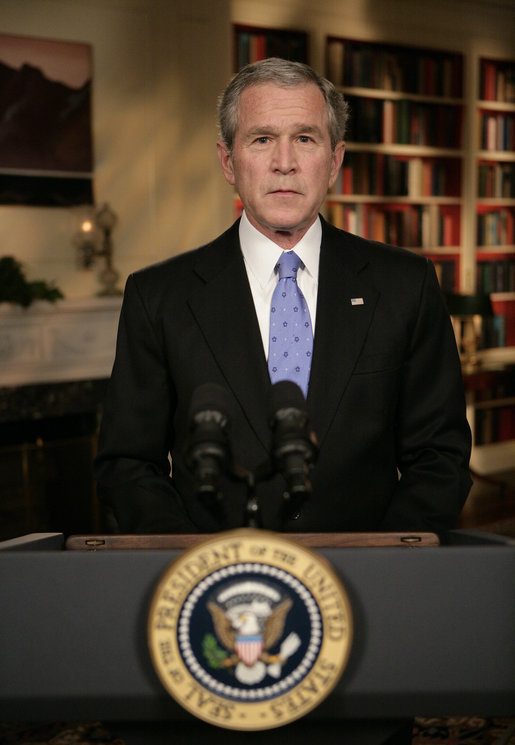“If I were a state legislator, I’d vote for it to move off the grounds — out of the state.” Another MLK day means another chance to lament the embarrassment that is the Confederate flag flying prominently outside my home State House (albeit no longer above the Capitol.) In South Carolina today, Senators and presidential hopefuls Chris Dodd and Joe Biden called for the flag’s removal. “Biden expects legislators here will eventually move the flag. Pointing to his heart, he said, ‘as people become more and more aware of what it means to African-Americans here, this is only a matter of time.’”
Category: World at Large
This is how we say goodbye in Germany.
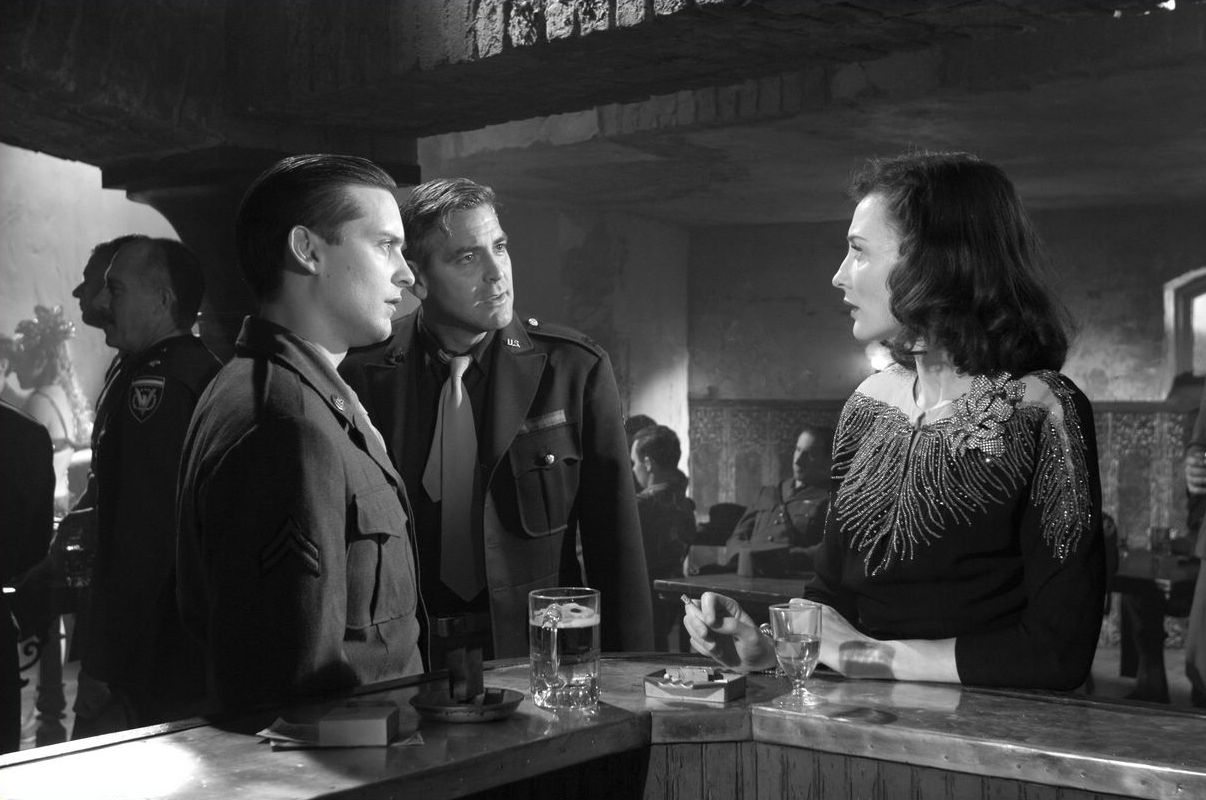
To his credit, Steven Soderbergh is relentlesssly experimental. When he’s at the top of his game (Out of Sight, Traffic, The Limey), few directors are better at telling stories that move with purpose and imagination, and even some of his resolutely mainstream projects (Erin Brockovich, Ocean’s 11, Ocean’s 12) –which might have been staid and forgettable in someone else’s hands — have verve and originality to spare. But, even for a guy as talented as Soderbergh, you keep taking swings, and eventually you’re going to whiff a few. (Full Frontal and Kafka come to mind — I haven’t seen Schizopolis or Bubble, but have heard they might be in this category too.) Alas, Stephen Soderbergh’s period noir, The Good German, is in this latter camp. Written with a 21st century sophistication about sex and language but filmed in the manner of a 1940s war flick — back projections, ancient credits, garish score, and all — German basically comes across as a two-hour gimmick, one that sadly outlasts its welcome by the second reel. George Clooney and Cate Blanchett do what they can (and both look great in B&W), but, surprisingly, the film just never engages — it feels flat and uninvolving from start to finish. In sum, as with the Solaris remake, Soderbergh and Clooney’s errant stab at big-think sci-fi, The Good German feels fundamentally misconceived.
Berlin, 1945. The war in Europe is over, and, divided into four sectors by the victorious Allies, Germany’s capital is now a sordid morass of blackened buildings and anything-goes. Venturing into the urban decay is former resident Jake Geismer (Clooney), now a TNR correspondent sent to cover the Potsdam Conference (which in its own way feels as improbable as Ocean buddy Matt Damon playing a 45-year-old in The Good Shepherd.) But, not ten minutes back in town, Geismer’s wallet is stolen by his too-friendly-by-half army driver (Tobey Maguire, laughably miscast), who, as it so happens, is a well-connected black marketeer, a despicable lout, and the current boyfriend and pimp of Geismer’s old flame, Lena Brandt (Blanchett). After a body shows up at Potsdam, and after that old flame is rekindled, Geismer finds himself tracking down a story that may or may not involve hidden war crimes, atomic secrets, Russian n’er do wells, German scientists, his old prosecutor buddy (Leland Orser), and of course, Lena, a girl who — like so many residents in her fallen city — has faced unspeakable horrors and kept them under wraps.
All well and good…who doesn’t enjoy a seamy noir? But, The Good German is curiously inert, and never gets off the tarmac. The plot ends up being byzantine in its mechanics, as a decent detective story should be, but German never arouses enough interest to makes the many twists and turns feel earned. Tobey Maguire doesn’t help — A decent actor with the right material (say, as Peter Parker), he’s so woefully bad here that it kills the movie from the start. (Also, a random quibble: Maguire also beats up Clooney at one point, as Clooney’s Geisberg is of the Tom Reagan school of noir heroes: he gets his ass kicked a lot. But, unless this is Golden Age Spiderman or something, it makes very little sense here.) But equally jarring is the disparity between the script and the look in The Good German: The period recreation, however clever at times, ends up distracting from rather than enhancing the tale being told. In all honesty, it just doesn’t work.
If The Good German does offer any distinct pleasures, they’re mostly in the margins. Deadwood‘s Robin Weigert (a.k.a. Calamity Jane) plays pretty far from type — the blunt-spokenness notwithstanding — as Lena’s brash, hooker roommate. And, even despite the general failure here, Soderbergh still has a great eye, and the black-and-white cinematography does pay occasional dividends (despite many of the outdoor scenes having a grainy, washed-out look to them.) Speaking of which, I’d be remiss if I didn’t note that the highlight of The Good German for me was Soderbergh’s framing of Cate Blanchett as a classic screen siren. True, her femme fatale accent occasionally lapses into something more like Natasha from Rocky and Bullwinkle than Garbo or Dietrich. But, a beautiful woman under any circumstances, Blanchett often looks breathtaking here, what with all the period accoutrements and chiaroscuro lighting at her service. Careful, Jake, it’s Berlintown…and she’s going to play you for a fool, yes it’s true.
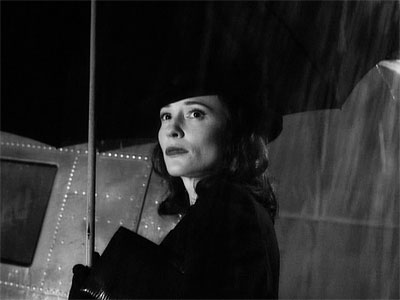
Iraq is a Hard Place.
“Our troops in Iraq have fought bravely. They have done everything we have asked them to do. Where mistakes have been made, the responsibility rests with me.” I’m still furiously playing catch-up, so I’m obviously a day or two behind on blogging this…Then again, Dubya’s just as obviously three or four years behind in announcing it, so I’ll call it a wash. Nonetheless, after finally admitting that his administration has seriously screwed up in Iraq, Bush — sidestepping the suggestions of the Baker-Hamilton commission — calls for sending 21,500 more troops to the region, in what’s being billed as a “surge.” (Re: “escalation.”) When you get right down to it, Dubya’s basic argument in his televised address on Wednesday was this: “Through wishful thinking and outright incompetence, I’ve dug two nations into a huge hole. Please, please, please let me keep digging…“
Here’s the thing — A massive troop increase would’ve made a good deal of sense in 2003, during those crucial days just after the fall of the Hussein regime. A show of power then — and a quicker restoration of order and basic services — would have paid huge dividends down the road. But, now, all these years later, after so much infrastructure has been destroyed and so many sectarian schisms have been allowed to fester? 21,500 troops — many of them not fresh recruits but wearied soldiers returning to the region or having their tours extended — isn’t going to make a dent in the Whack-a-Mole game we’ve been playing against insurgents since 2003. At best, this escalation is a show of good faith to the al-Maliki government, which seems to be not much more than a brittle political arm of Shiite extremists (Exhibit A: the manner of Saddam’s hanging; Exhibit B: the refusal to do anything — until now — to rein in Al Sadr’s Mahdi Army.) Yes, folks, throwing more troops at a losing situation, backing a shaky government that can’t handle its own security issues, rattling the saber at Cambodia/Iran…who says Dubya isn’t a student of history?
Fortunately, for the first time since the beginning of the war, Congress isn’t having it, with even some Republicans joining Dems in rallying against the proposed troop increase and today venting their wrath at Condi Rice before the Senate Foreign Relations Committee. (No doubt the poll numbers against Dubya’s plan is helping to stiffen some GOP spines.) Still, Dubya has some allies in this fight — While the Dems are universally opposed to the escalation gamble [Dem Response by Durbin | Biden | Clinton | Dodd | Edwards | Feingold | Obama | Pelosi] and a not-insubstantial number of Republicans are balking, some key GOP pols are still supporting Dubya’s move (most notably John McCain, who’s been calling for a troop increase since day one, and Rudy Giuliani, likely trying to right the 2008 ship after his recent devastating document dump.)
It Takes an Empire.

[%@*#, that’s aggravating. Movable Type just ate my entire review. Ok, let’s try this again.] A lush, operatic saga of a cancerous ninth-century family fracas that threatens to topple the Tang Dynasty from within, Zhang Yimou’s Curse of the Golden Flower is the type of film for which the cliche “sumptuous visual feast” was coined. True, this sordid tale of betrayal, corruption, incest, and time-release murder is overwrought to the point of self-parody, and the action sequences — like those in Zhang’s House of Flying Daggers — eventually veer well past rousing to the far corner of preposterous. But, my, is this film gorgeous to look at: From start to finish, Curse of the Golden Flower is an explosion of riotous color. (Particularly after sitting through two hours of Letters from Iwo Jima‘s bleak, monochrome grays, viewing the veritable kaleidoscope on display here felt even more sensuous and indulgent.) Throw in some very watchable performances by Chow Yun-Fat, Gong Li, and others, and Curse comes across to me as the best entrant in Zhang’s recent trilogy of fanciful-historical Chinese epics (That would be Curse, Daggers, and the scarily nationalistic Hero — Fortunately the political subtext is more restrained and ambiguous here. In fact, Curse may even be revolutionary, depending on how you read the film’s final image.)
It is the hour of the rat for the Tang Dynasty, chrysanthemums bloom throughout the Middle Kingdom, and opulence comingles with palace intrigue in the halls of the Forbidden City. For the Emperor (Chow Yun-Fat, both fierce and serene), in his Divine wisdom, has seen fit to slowly and secretly poison his Empress (Gong Yi, equally good), by means of a deathly black fungus added to her daily medicine. The Empress, meanwhile, strains to rekindle her romance with the Emperor’s first son (by a previous marriage), the Crown Prince Wan (Liu Ye), but he only has eyes for a fetching maid (Li Man) in the imperial employ. (In fact, she is the daughter of the doctor administering the poison.) And also residing in this increasingly broke down palace are the Princes Jai (Jay Chou) and Yu (Qin Junjie), both of whom discover they have their own roles to play in the schemes of their feuding parents, particularly after the ailing Empress weaves a plot of vengeance to coincide with the coming festival…
Also milling about the Forbidden City is a cast of hundreds: the cooks, maids, laborers, soldiers, ninjas (Yes, this film has ninjas, or at least their Chinese equivalent), and ladies-in-waiting that make up the infrastructure undergirding the Tangs’ divine rule. Zhang goes out of his way here to emphasize the sheer amount of sweat and toil expected of this teeming support staff for even the most mundane task — It takes at least four servants to administer the Queen’s medicine and considerably more to cart the Emperor to and fro. Yet, Zhang seems to suggest, these people are as much part of the story as the resentful royals. They are the props of the extravagant ritual, rigid hierarchy, and striking beauty that characterize the Tang’s rule, and they are ennobled by knowing and playing their appropriate role in this imperial order. Whether or not you agree with this sentiment (and Zhang himself seems to cast doubt on it by the final shot), it does make for several breathtaking scenes of elaborate ceremony throughout the film.
And, yes, some of these are battles. To be honest, both Hero and House probably exhibited better fight choreography. If you come to Curse expecting a martial arts extravaganza akin to those films, you may well leave disappointed. I found the final Helms’ Deepish “silver versus gold” sequence to be too bloodthirsty (beheading prisoners and such), too unrealistic (here, more than anyone else in the film, physics don’t apply) and too obviously CGI for my taste. That being said, there are a few notable melees interspersed throughout the picture, most of them involving the black-clad, scythe-wielding “Flying Monkey”ish ninjas of the Imperial Army, who tend to swoop down from above and bury their scythes in the nearest possible revolutionary with extraordinary aplomb. (Sigh. Only one movie after Iwo Jima, and war and violence are already being made to look artful again.)
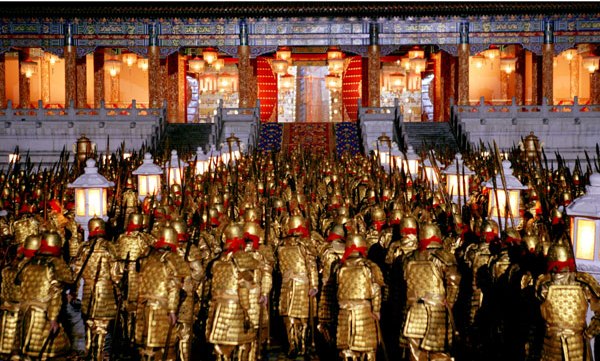
Letters Never Sent.
 While I thought most critics lavished too much praise on Pan’s Labyrinth, the very similar swells of appreciation for Clint Eastwood’s Letters from Iwo Jima are, surprisingly, much closer to the mark. Eastwood’s first crack at Iwo Jima in 2006, Flags of our Fathers, was to my mind a well-meaning dog, one made particularly lousy by the heavy-handed fingerprints of Paul Haggis all over the film. But (perhaps due to the different screenwriter, Iris Yamashita), Letters is really something quite remarkable. A mournful, occasionally shocking testament to the inhumanity and absurdities attending war, and a elegiac dirge for those caught in its grip, even on the other side of the conflict, Letters from Iwo Jima is an impressive — even at times breathtaking — siege movie. And strangely enough, elements that seemed trite or intrusive in Flags — the desaturated landscape, the minimalist piano score — are truly haunting and evocative here. In fact, Letters from Iwo Jima is so good it even makes Flags of our Fathers seem like a better movie just by association, which, trust me, is no small feat.
While I thought most critics lavished too much praise on Pan’s Labyrinth, the very similar swells of appreciation for Clint Eastwood’s Letters from Iwo Jima are, surprisingly, much closer to the mark. Eastwood’s first crack at Iwo Jima in 2006, Flags of our Fathers, was to my mind a well-meaning dog, one made particularly lousy by the heavy-handed fingerprints of Paul Haggis all over the film. But (perhaps due to the different screenwriter, Iris Yamashita), Letters is really something quite remarkable. A mournful, occasionally shocking testament to the inhumanity and absurdities attending war, and a elegiac dirge for those caught in its grip, even on the other side of the conflict, Letters from Iwo Jima is an impressive — even at times breathtaking — siege movie. And strangely enough, elements that seemed trite or intrusive in Flags — the desaturated landscape, the minimalist piano score — are truly haunting and evocative here. In fact, Letters from Iwo Jima is so good it even makes Flags of our Fathers seem like a better movie just by association, which, trust me, is no small feat.
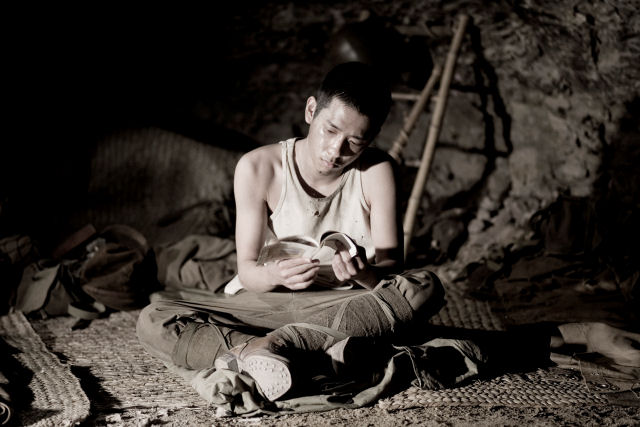 As you probably know by now, Letters from Iwo Jima follows the famous World War II battle, ostensibly depicted in Flags, from the Japanese side. Here, nobody cares about artfully raised flags or the Ballad of Ira Hayes — the emphasis instead is on honor and survival. General Tadamichi Kuribayashi (Ken Watanabe, as captivating here as he was in The Last Samurai) has been ordered to lead the defense of the island against the Americans. To this task, he fully devotes himself, despite fond memories of his earlier days on US soil. But it only takes a few walks around Mt. Suribachi for Kuribayashi to figure out it’s pretty much a no-win scenario — the Americans are too many, too productive, and too strong. And once word leaks out that the Japanese fleet has been broken at Leyte Gulf, Kuribayashi and his men — most notably friendly grunt Saigo (Kazunari Ninomiya), and former Kempetai Shimizu (Ryo Kase) — must slowly come to grips with the fact that they’re not digging cavern defenses so much as their own tomb…a tomb in which many Japanese officers, and not least the headquarters on the homeland, will expect them to die with honor.
As you probably know by now, Letters from Iwo Jima follows the famous World War II battle, ostensibly depicted in Flags, from the Japanese side. Here, nobody cares about artfully raised flags or the Ballad of Ira Hayes — the emphasis instead is on honor and survival. General Tadamichi Kuribayashi (Ken Watanabe, as captivating here as he was in The Last Samurai) has been ordered to lead the defense of the island against the Americans. To this task, he fully devotes himself, despite fond memories of his earlier days on US soil. But it only takes a few walks around Mt. Suribachi for Kuribayashi to figure out it’s pretty much a no-win scenario — the Americans are too many, too productive, and too strong. And once word leaks out that the Japanese fleet has been broken at Leyte Gulf, Kuribayashi and his men — most notably friendly grunt Saigo (Kazunari Ninomiya), and former Kempetai Shimizu (Ryo Kase) — must slowly come to grips with the fact that they’re not digging cavern defenses so much as their own tomb…a tomb in which many Japanese officers, and not least the headquarters on the homeland, will expect them to die with honor.
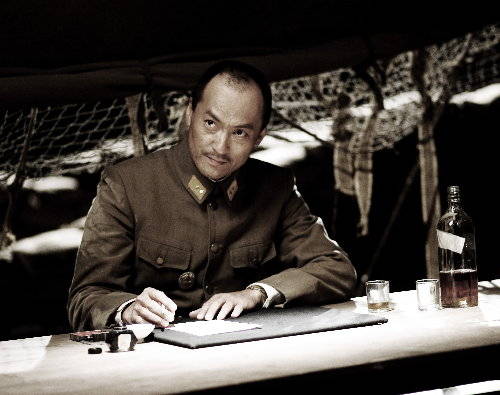 What’s particularly surprising here is how unafraid Eastwood is to invert the usual sympathies of a World War II film. It’s not just that the Japanese are the “good guys” here — True, Letters dramatizes the soldiers’ plight by portraying them, particularly Saigo, as just like our fun-loving GI’s at heart. But it also doesn’t shy away from examining a cultural emphasis on dying well that seems completely foreign to the American mind. And, although a wounded American serviceman shows up later in the film, for the most part the US forces are — surprisingly — portrayed here like something out of The Empire Strikes Back, all gleaming, remorseless battleships and Fiery Death from Above. (Some have argued that Eastwood elides over Japanese atrocities in this film, but I’m not sure that’s really fair, unless I somehow just missed the Dresden firebombing subplot in Saving Private Ryan. This is not to say that all war crimes are equivalent or that both sides are equally guilty (although Lord knows it got ugly) — that gets into a moral calculus well outside the bounds of this review — only that Letters seems more interested in portraying war itself as an atrocity, and that enough reference is made to ugly tactics (aiming at medics, for example) that the film doesn’t feel to me like a whitewash.)
What’s particularly surprising here is how unafraid Eastwood is to invert the usual sympathies of a World War II film. It’s not just that the Japanese are the “good guys” here — True, Letters dramatizes the soldiers’ plight by portraying them, particularly Saigo, as just like our fun-loving GI’s at heart. But it also doesn’t shy away from examining a cultural emphasis on dying well that seems completely foreign to the American mind. And, although a wounded American serviceman shows up later in the film, for the most part the US forces are — surprisingly — portrayed here like something out of The Empire Strikes Back, all gleaming, remorseless battleships and Fiery Death from Above. (Some have argued that Eastwood elides over Japanese atrocities in this film, but I’m not sure that’s really fair, unless I somehow just missed the Dresden firebombing subplot in Saving Private Ryan. This is not to say that all war crimes are equivalent or that both sides are equally guilty (although Lord knows it got ugly) — that gets into a moral calculus well outside the bounds of this review — only that Letters seems more interested in portraying war itself as an atrocity, and that enough reference is made to ugly tactics (aiming at medics, for example) that the film doesn’t feel to me like a whitewash.)
The sobering truth at the heart of the grim, moving Letters from Iwo Jima is captured in its penultimate image. (Alas, like too many WWII films, Eastwood opts for an unnecessary contemporary bookend, but it’s not as distracting as the Greatest Generation stuff in Flags. In fact, you might argue that it plays very well off those scenes, in depicting what little survives the war on the Japanese side.) I won’t give it away here…suffice to say that Letters makes clear that War is a demon that rips lives apart and rends men asunder, no matter what side you’re on or for what reasons. Regardless of race, creed, nationality, or ideology, all who invoke its wrath will eventually come to taste tragedy.
Excessive Fauning.
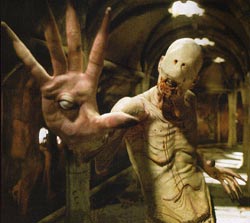 Well, I’m not very happy about being on the other end of the review spectrum for this film, which was one I’d been really looking forward to. But, I must confess, I’m somewhat mystified by the almost-universally stellar reviews that have accompanied Guillermo del Toro’s Pan’s Labyrinth. It’s not a bad movie by any means, but I found it the least accomplished of this year’s crop of A-list genre films (The Prestige, Children of Men, The Fountain — the latter in particular seems to have been unfairly maligned in comparison to this one.) Billed as a “fairy tale for grown-ups,” Pan’s Labyrinth is a diverting but disconnected hodgepodge of fantasy, horror, and historical fiction, held together, if at all, only by occasional reference to Del Toro’s usual visual affinities, such as creepy insects, yonic symbols, punctured/torn flesh, and Doug Jones in funny suits. And as far as fantastical tales of children during the Spanish Civil War go, Del Toro has tread this ground before with the haunting Devil’s Backbone, and, to be honest, I preferred that film in almost every regard.
Well, I’m not very happy about being on the other end of the review spectrum for this film, which was one I’d been really looking forward to. But, I must confess, I’m somewhat mystified by the almost-universally stellar reviews that have accompanied Guillermo del Toro’s Pan’s Labyrinth. It’s not a bad movie by any means, but I found it the least accomplished of this year’s crop of A-list genre films (The Prestige, Children of Men, The Fountain — the latter in particular seems to have been unfairly maligned in comparison to this one.) Billed as a “fairy tale for grown-ups,” Pan’s Labyrinth is a diverting but disconnected hodgepodge of fantasy, horror, and historical fiction, held together, if at all, only by occasional reference to Del Toro’s usual visual affinities, such as creepy insects, yonic symbols, punctured/torn flesh, and Doug Jones in funny suits. And as far as fantastical tales of children during the Spanish Civil War go, Del Toro has tread this ground before with the haunting Devil’s Backbone, and, to be honest, I preferred that film in almost every regard.
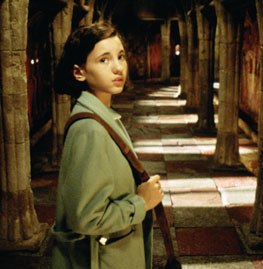 So, here’s the setup: Once upon a time — 1944, to be exact — there was a young girl on the verge of adolescence named Ofelia (Ivana Baquero) who was forced to accompany her sickly, pregnant mother (Ariadna Gil) into the Spanish countryside, and to live with her wicked (Fascist) stepfather (Sergi Lopez of Dirty Pretty Things, and I do mean wicked — he beats an old man’s face into bloody fragments within the first twenty minutes.) Although befriended by a kindly maid (Y Tu Mama Tambien‘s Maribel Verdu) — one who may have ties to Republican remnants in the nearby mountains — Ofelia is deeply disconsolate in her new home. That is, until a congenial fairy-mantis she encountered on her way in takes her deep into the nearby garden labyrinth, where an unnerving faun (Doug Jones) discloses that she may in fact be a long-lost princess of an underground world. To claim her birthright, Ofelia must first accomplish three fairy-tale-type tasks, all the while evading her wicked stepfather and doing what she can to protect her ailing mother. But, much to her dismay, Ofelia soon finds that her fantasy world can be just as dangerous and even deadly as her stepfather’s company, particularly once the two worlds begin to collide.
So, here’s the setup: Once upon a time — 1944, to be exact — there was a young girl on the verge of adolescence named Ofelia (Ivana Baquero) who was forced to accompany her sickly, pregnant mother (Ariadna Gil) into the Spanish countryside, and to live with her wicked (Fascist) stepfather (Sergi Lopez of Dirty Pretty Things, and I do mean wicked — he beats an old man’s face into bloody fragments within the first twenty minutes.) Although befriended by a kindly maid (Y Tu Mama Tambien‘s Maribel Verdu) — one who may have ties to Republican remnants in the nearby mountains — Ofelia is deeply disconsolate in her new home. That is, until a congenial fairy-mantis she encountered on her way in takes her deep into the nearby garden labyrinth, where an unnerving faun (Doug Jones) discloses that she may in fact be a long-lost princess of an underground world. To claim her birthright, Ofelia must first accomplish three fairy-tale-type tasks, all the while evading her wicked stepfather and doing what she can to protect her ailing mother. But, much to her dismay, Ofelia soon finds that her fantasy world can be just as dangerous and even deadly as her stepfather’s company, particularly once the two worlds begin to collide.
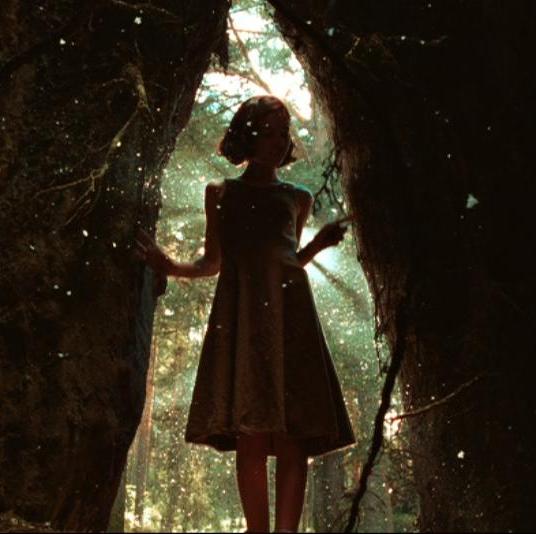 But do they collide? Perhaps I missed some vital subtext, but I found Ofelia’s dreamworld adventures — other than the “Girl, you’ll be a Woman soon” flourishes, like the bloody book — to be generally remote both from her problems at home and from the Republican-Fascist feud, other than that all three narrative strands grow increasingly grisly and grotesque. And, while certain scenes definitely linger in the senses like eerie reminiscences of a fever dream, most notably the Wraith’s Table, they don’t really serve the larger story in any way I could fathom. (Also, why does Ofelia suddenly decide to go all Augustus Gloop in that scene anyway? Dream logic, I guess, but it seemed out of character.) Throw in a few second-act torture scenes that are more off-putting than they are resonant or even necessary, and Labyrinth starts to wear thin well before the end. In sum, Pan‘s a decent film that’s worth seeing if you’re in the mood for it, but it’s by no means the genre classic it’s being made out to be. Perhaps the subtitles gave it gravitas in some corners, but, to my mind, Pan’s Labyrinth gets a little lost in its own maze.
But do they collide? Perhaps I missed some vital subtext, but I found Ofelia’s dreamworld adventures — other than the “Girl, you’ll be a Woman soon” flourishes, like the bloody book — to be generally remote both from her problems at home and from the Republican-Fascist feud, other than that all three narrative strands grow increasingly grisly and grotesque. And, while certain scenes definitely linger in the senses like eerie reminiscences of a fever dream, most notably the Wraith’s Table, they don’t really serve the larger story in any way I could fathom. (Also, why does Ofelia suddenly decide to go all Augustus Gloop in that scene anyway? Dream logic, I guess, but it seemed out of character.) Throw in a few second-act torture scenes that are more off-putting than they are resonant or even necessary, and Labyrinth starts to wear thin well before the end. In sum, Pan‘s a decent film that’s worth seeing if you’re in the mood for it, but it’s by no means the genre classic it’s being made out to be. Perhaps the subtitles gave it gravitas in some corners, but, to my mind, Pan’s Labyrinth gets a little lost in its own maze.
Much Support for the Monarchy.
 Just as I didn’t have much hankering to see a film about United 93 at first, I’ve been presuming that not much would interest me less than a movie about the aftermath of Princess Diana’s death in 1997. (Obviously, the loss of any relatively young person in a car crash, particularly one as committed to international concerns as Diana was, is tragic. But in all honesty, when I think of the hubbub and hysterics surrounding her untimely death, it reminds me of the “Baby Diego” sequence in Children of Men.) That being said, I’m happy to say that Stephen Frears’ The Queen is, like United 93, a surprisingly good depiction of recent history. Less a paean to “the people’s princess” than a sharp-witted rumination on changing social values and the effect of global “Oprahization” on contemporary politics, The Queen is an intelligent, discerning and enjoyable slice-of-life that’s well worth catching.
Just as I didn’t have much hankering to see a film about United 93 at first, I’ve been presuming that not much would interest me less than a movie about the aftermath of Princess Diana’s death in 1997. (Obviously, the loss of any relatively young person in a car crash, particularly one as committed to international concerns as Diana was, is tragic. But in all honesty, when I think of the hubbub and hysterics surrounding her untimely death, it reminds me of the “Baby Diego” sequence in Children of Men.) That being said, I’m happy to say that Stephen Frears’ The Queen is, like United 93, a surprisingly good depiction of recent history. Less a paean to “the people’s princess” than a sharp-witted rumination on changing social values and the effect of global “Oprahization” on contemporary politics, The Queen is an intelligent, discerning and enjoyable slice-of-life that’s well worth catching.
As the film begins — after a wink similar to the one opening Marie Antoinette — the young, charming, and recently-elected face of New Britain, Tony Blair (Michael Sheen), ventures to Buckingham Palace with resolutely anti-monarchist wife Cherie (Helen McCrory), in order to request of his sovereign Queen Elizabeth II (Helen Mirren) that he be allowed to form a government. A study in contrasts, the emotive, familiar prime minister and the punctilious, reticent Queen get on less well as exemplars of New and Old England than, say, Peel and Steed. Reared and residing in a bastion of venerable tradition, where faxes are still delivered in a wicker basket and feelings are not discussed, Queen Elizabeth has little patience for Blair’s studied informality and populist bonhomie. But, when tragedy strikes several months later, in the form of Princess Diana’s death at the hands of the loathsome paparazzi, the Crown finds itself soon embroiled in a downward spiral of their own making, as — the Prince of Wales (Alex Jennings) notwithstanding — the royal family shows little inclination to convert their grief into a public display (or to honor someone they’ve come to perceive as an impulsive and manipulative interloper.) And, when England’s people begin to surround Buckingham Palace with wreaths and bouquets that come to seem as menacing as torches and pitchforks, it falls on the prime minister to attempt to instruct the Queen on the vagaries of politics in the Tabloid era, before permanent damage is wrought upon the monarchy.
More than United 93, the film that actually comes to mind when watching The Queen is Nixon. Like Oliver Stone’s film, The Queen attempts to humanize a oft-maligned world figure for whom much of the audience may have little sympathy. Like Nixon, it portrays a government increasingly besieged by its own people, and a bewildered political leader who finds they’ve lost touch with their electorate or subjects (Consider the scene of Nixon at the Lincoln Memorial, or all the perhaps over-the-top talk of “the beast” therein.) And, of course, the Queen’s relationship to the fallen Diana is depicted here much like Nixon’s (and LBJ’s) to John — and later Bobby — Kennedy. This holds true particularly in the later scenes of the film, as Elizabeth is forced to confront the fact that, for all her sacrifices, she’ll never compete with the fallen princess in the public’s esteem.
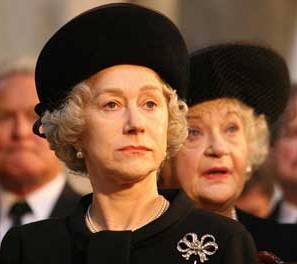 The emotions this sad realization elicits, along with many others in the film, are visible only in the margins of Helen Mirren’s mask of public composure, bringing home the conflict between restraint and immodesty (or, if you’d prefer, suppression and sensitivity) at the center of the film. Mirren, as always, is excellent here, and I’d guess her Oscar is already in the bag: She invests her monarch with grace and dignity even while frumpily walking her dogs down the lane, and rises above the very occasional clunks in the script (The buck stops here, indeed.) And Michael Sheen’s Tony Blair grows on you. At first, he seems off, but eventually you get the sense that he conveys Blair’s more notable qualities rather well: intelligence, boyishness, a way with people, and a potentially problematic penchant for deference. (Indeed, just when it seems the movie’s portrayal of Blair has grown cloying beyond words, Mirren’s Queen puts him in his place, and ties 1997’s hero of Labor to the more troubling Blair of today, one who could and should have more aggressively instructed his American counterpart on the vagaries of leadership in the reality-based world.)
The emotions this sad realization elicits, along with many others in the film, are visible only in the margins of Helen Mirren’s mask of public composure, bringing home the conflict between restraint and immodesty (or, if you’d prefer, suppression and sensitivity) at the center of the film. Mirren, as always, is excellent here, and I’d guess her Oscar is already in the bag: She invests her monarch with grace and dignity even while frumpily walking her dogs down the lane, and rises above the very occasional clunks in the script (The buck stops here, indeed.) And Michael Sheen’s Tony Blair grows on you. At first, he seems off, but eventually you get the sense that he conveys Blair’s more notable qualities rather well: intelligence, boyishness, a way with people, and a potentially problematic penchant for deference. (Indeed, just when it seems the movie’s portrayal of Blair has grown cloying beyond words, Mirren’s Queen puts him in his place, and ties 1997’s hero of Labor to the more troubling Blair of today, one who could and should have more aggressively instructed his American counterpart on the vagaries of leadership in the reality-based world.)
Musical Chairs for Team Dubya.
In not-unrelated news, the Dubya White House shuffles its deck to make ready for divided government, replacing failed Supreme Court bid Harriet Miers as White House counsel (likely in favor of someone more aggressive, so as to counter Dem subpoenas), kicking national intelligence director Nicholas Negroponte over to State (to be replaced by Vice Admiral Mike McConnell), appointing Thomas D’Agostino as new nuclear chief (the old one, Linton Brooks, seems to have been of the “Brownie” school of management), putting Iraq ambassador Zalmay Khalilzad in John Bolton’s former position at the UN (his job goes to Ryan Crocker), and overhauling their top military team in Iraq. As the WP‘s Dan Froomkin reads the tea leaves, “I see a possible theme: A purge of the unbelievers.”
Ban Ki-Moon (and Spitzer) Rising.
Other important leadership shifts, these in and around New York: Having officially replaced Kofi Annan at the UN earlier this week, new general secretary Ban Ki-Moon cleans house, announces his own team and sets the Darfur crisis as a top priority. And, over in Albany, New York governor (and future presidential contender?) Eliot Spitzer delivers both his first Inaugural [text] and his first State of the State [PDF]: “In an hourlong address that was largely a repudiation of the policies of his predecessor, George E. Pataki, the new governor said he would seek to broadly overhaul the state’s ethics and lobbying rules. He said he would make prekindergarten available to all 4-year-olds by the end of his term, overhaul the public authorities that control most of the state’s debt and make New York more inviting to business by reducing the cost of workers’ compensation.“
Just Like Tom Thumb’s Blues, Redux.
Hey all…I’m now back in New York City, tan, rested, and ready for whatever 2007 may bring. (I hope.)

